Blackberries: popular varieties, cultivation and care
Blackberry Is a forest sweet berry that looks like mulberry and raspberry at the same time. It is customary to meet this plant in forest thickets in clearings. Recently, breeders have domesticated blackberries and developed many different varieties for growing berries in different regions and natural conditions.
Content:
- General information about the blackberry
- Varieties
- Care Tips
- Transplanting and pruning blackberries
- Reproduction methods
- Diseases and pests
- Application of branches and fruits
General information about the blackberry
Blackberry Is a perennial deciduous plant that belongs to the Rosaceae family. It grows as a shrub with creeping and straight long branches, the surface of which is covered with thorns. Recently, there are hybrid varieties without thorns. The closest relatives of blackberries include raspberries, the structure of the plant and berries are outwardly similar. Its homeland is America, the plant got to Europe only in the 18th century.
Blackberry is an unpretentious plant and tolerates drought well thanks to a powerful root system that goes deep into the ground and spreads widely over the surface.
Branches on bushes develop in two stages. In the first year, young shoots are formed, which stretch and grow stronger over the season. These branches bear fruit the following year and are removed when pruning at the end of the season.
It blooms with small white flowers from early summer to mid-autumn. Black berries, depending on the variety, come in different sizes. Hybrid varieties with yellow and red fruits also appeared.
Varieties
Popular blackberry varieties:
- Blackberry Natchez. The bushes are vigorous, the branches grow straight and begin to bend at a height of about 1 meter. The hybrid variety was bred by breeders without thorns. The ripening period lasts 1-1.5 months, the berries are large, have a cylindrical shape, painted in a rich black color, glossy. The variety is early, ripening begins at the end of June.
- Blackberry Triple Crown. A large shrub with upright branches. The leaves are large, colored in a dark green tone. No thorns, hybrid variety. The fruit is a composite drupe, large, in a mature state, colored in a black tone. The pulp is tender, juicy, sweet taste. The variety is suitable for industrial use and for planting in gardens and summer cottages. Ripening period is average, fruits can be harvested from the end of July.
- Blackberry Jumbo. The bush of this variety has erect stems and a compact shape, so that the plant can be planted close to one another. The leaves are large in size, with pronounced veins, painted in a green tone. Fruits are large, juicy, sweet, black, glossy, ripen on a cluster of several fruits. One berry can weigh up to 30 grams. Harvesting begins in late July and lasts several weeks as it ripens.
- Blackberry Karaka Black. The bush is medium-sized, compact with erect stems. Branches are strong, covered with thorns. Leaves are large with veins, dark green tone. The berries are large, oval, up to 5 cm in length, in a mature state they are painted in a black tone. The pulp is soft and juicy, the taste is sweet and sour.Harvesting can begin in mid-summer and lasts about 6 weeks.
- Blackberry Oregon Thornless. The bush is large, tall, the stems are spreading, thick, without thorns. The variety is distinguished by its beautiful, carved, decorative medium-sized leaves, tinted green. The berries are round in shape, small in size, painted in a rich black color. The pulp is soft, juicy and very sweet. Well transported. Harvesting begins in mid-August and lasts 4-5 weeks.
Care Tips
Development and care for blackberries are similar to raspberries. Good place for development, timely watering and feeding will give a good annual harvest. It is recommended to plant a blackberry on heights, where the sun warms the earth well, there is no stagnation of water and winds. With the constant supply and stagnation of cold air, young shoots can die, which will lead to a loss harvest... If, during spring thaw, water accumulates and remains near the roots for a long time, this can lead to rotting or frostbite of the roots during spring frosts, which will lead to the death of the entire bush.
The soil should be loose, fertile and well-drained.
Its composition should be medium loamy. If there is no such soil on the site, before planting it is necessary to prepare the place by digging up the ground along with compost and a large part of river sand. It is recommended to add organic and mineral fertilizers containing phosphorus and potassium. Also recommended before disembarking seedlings decontaminate the soil in order to prevent various diseases.
Blackberries are drought-resistant plants. But during the formation and ripening of berries, the bushes must receive a sufficient amount of moisture. It also affects the development and maturation of young shoots. In conditions of a lack of water, the stems of the first year do not have time to get stronger by the winter, this leads to winter freezing and the loss of most of the harvest in the next season. In summer, gardeners recommend periodically sprinkling the branches and leaves of bushes with water in the evening.
For good development of the bush and a plentiful annual harvest, it is necessary to constantly feed the plant with organic and mineral fertilizers:
- This is especially true in the spring, when young shoots begin to grow and develop, and during the periods of formation and ripening of fruits.
- In the spring, organic and mineral fertilizers are applied, when budding begins, potassium-containing dressings are applied under the bushes.
- During the ripening of the fruit, complex fertilizers are applied.
- Everything is brought under the bush after abundant watering.
In cold regions, it is recommended to insulate branches and roots. blackberry for the winter. To do this, after pruning, before frost, all shoots are removed from the supports and bent to the ground. From above they are covered with spruce branches and special materials. In winter, a layer of snow will serve as an additional insulation. For frost-resistant varieties, it will be enough trimming... In the spring, all covering varieties open early so that the branches do not get stuck.
Transplanting and pruning blackberries
In one place, blackberries grow well for 10-12 years, after this time it is recommended transplant bush to a new place. For this process, early spring or autumn is suitable. Pre-prepare the deepening, as when planting young seedlings. The bush is carefully dug up, almost the entire above-ground part is cut off.
The root system must be carried along with the earthy clod in order to cause minimal harm to it. Dry and rotten roots are cut off. The bush is transferred to a new place, the root collar should remain at the same level. After all the ground is covered and the plant is abundantly watered, you can mulch.
It is recommended to prune the bushes every year in the fall.
But initially pruning carried out on young bushes the next year after planting.During this period, the plant is formed and the root system is strengthened. The next year, the branches are tied to the supports and the extra ones are removed. The remaining branches are shortened, leaving 1.5-1.8 meters.
In the autumn, the annual pruning takes place according to the same principle:
- Old branches that bore fruit in the current year are removed, young ones are shortened.
- Diseased stems are also cut.
- After winter, in the spring, repeated pruning is carried out, in which frozen branches are removed.
For the convenience of pruning, the shoots are tied with a fan to a stretched wire. Young shoots are directed to one side, fruiting branches are attached on the other side. Thus, the next year, space is made available for new young branches.
Reproduction methods
Reproduction blackberries with erect stems are carried out using root shoots and root cuttings... The bush gives a small root shoot. In this case, a young plant is carefully dug up in the autumn or early spring and planted in pre-prepared holes.
To propagate a plant with root cuttings, you must:
- Dig out a part of the root, cut it into pieces of 10-12 cm. Such cuttings are planted in the holes in a horizontal position.
- The process is carried out in early spring.
- Throughout the season, plantings are regularly watered, and after irrigation the soil is loosened.
- The roots are buried at a distance of no more than 10 cm.
- After a while, the first shoots will appear.
Creeping blackberry bushes practically do not produce basal offspring. Therefore, they can be propagated by green cuttings and layering. For propagation by layering, at the end of summer, ripe shoots are bent to the ground and the branch is attached in a small depression, so that after sprinkling with earth, 10 cm of the top remains on the surface. The place of attachment is regularly watered and fed, insulated for the winter period.
When pruning in autumn, cuttings are harvested from well-ripened and lignified shoots.
For a while, they are transferred to a dark, cool place, previously wrapped in a damp cloth. They should be there until January, the fabric is constantly moistened so that the branches do not dry out.
Before rooting, the cuttings are soaked in water and in stimulating solutions. A container with loose and fertile soil is being prepared, where the prepared branches are buried. 2-3 knots should remain on the surface. The container is transferred to a well-lit and warm place. Cuttings are constantly moisturized and fed with light solutions of nutrients and stimulants. To spring cuttings put down good roots, and when the ground warms up enough, they can be planted in a permanent place of growth.
Another breeding method that is suitable for all types of blackberries is dividing the bush:
- At the same time, all the characteristics of the mother plant are preserved.
- It is carried out in the early spring months or in the middle of autumn.
- At the same time, the entire bush is dug up, the rhizome is divided in such a way that several shoots remain on each new plant.
Young plantings require more careful care. Regular watering and additional fertilizing with mineral and organic fertilizers. Deleting weeds and loosening the soil. And protection from pests.
Diseases and pests
Blackberrylike raspberries susceptible to various diseases and pest attacks. Therefore, when a disease is found in one bush, the entire area is treated.
Rust attacks the leaves and fruits of the plant, and you can lose most of the crop. This disease occurs when the plants are weakened due to a lack of moisture during the dry season. You can fight this ailment in the folk way by sprinkling all the bushes with a strong infusion garlic... In this case, all fallen leaves are burned to prevent the reproduction of the disease.
Before budding, the bushes can be treated with a Bordeaux mixture solution.
Powdery mildew it can also infect plants, it is visible on berries in the form of a white bloom. It is a fungal disease and is treated like rust. Preventive treatment plants with special preparations in the spring.
If aphids or similar insects appear, the plant can be treated with soapy water or special insecticides.
Application of branches and fruits
Fruit blackberry contain large amounts of niacin and a wide range of many vitamins and minerals. Possessing antipyretic and medicinal properties, berries are used for medicinal purposes, both fresh and in teas and jams. Also, young blackberry leaves, which are harvested in the spring, have medicinal properties.
Blackberry branches grow well, braiding the supports. During flowering, the bush has a decorative appearance and decorates the site.
More information can be found in the video.





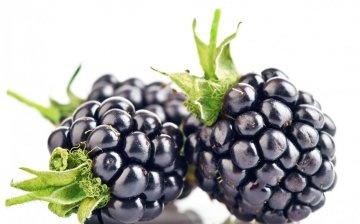
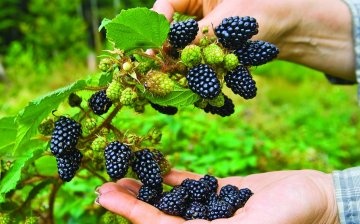

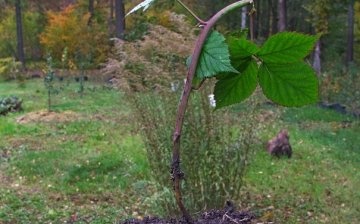
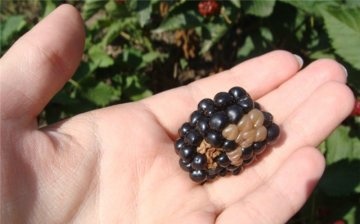
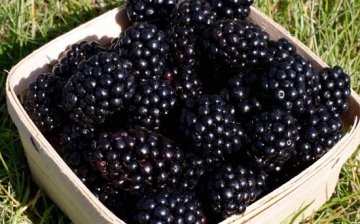








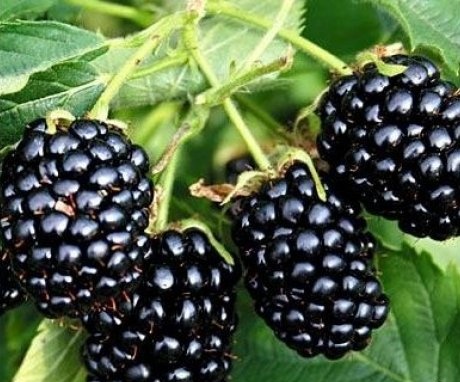
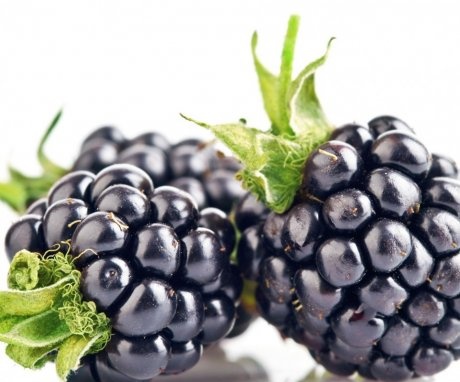
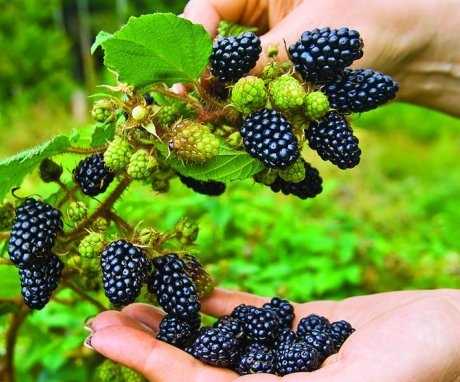
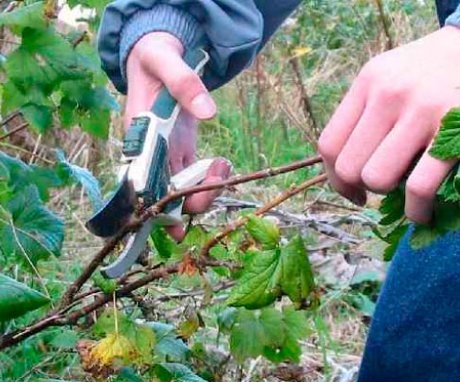

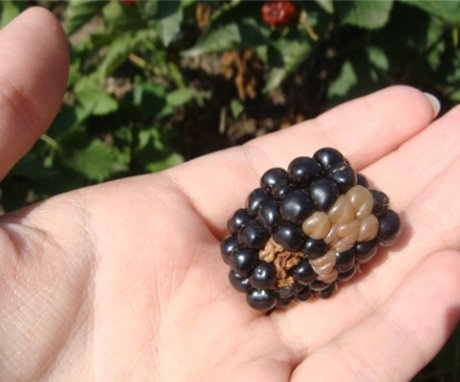

I have probably grown blackberries for more than five years. Will give birth well, though I don't really like to eat fresh berries, I prefer to make compote from them for the winter. Surprisingly, for all these years, blackberries have not hurt me in any way. I take care of the bush in the standard way: I water it, cut off the old branches, insulate it for the winter. I have not tried to multiply yet.